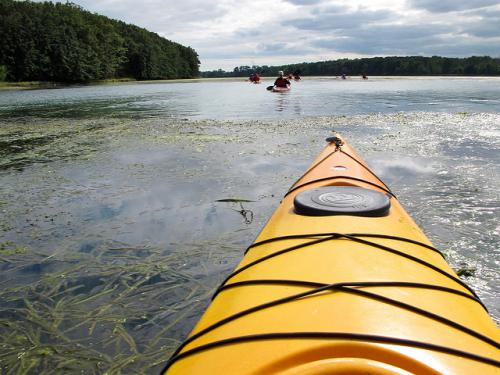Trails movement keeps growing in Michigan
Communities drawing more visitors with specialty nature-based attractions.
Michigan communities are always looking for ways to attract new visitors by taking advantage of natural resources and attractions. Trail systems are one way to encourage visitors to explore and enjoy unique areas. Michigan Sea Grant and Michigan State University Extension are helping communities around the state develop trail systems to attract visitors and also increase appreciation for Michigan’s natural resources.
Birding trails
Developing bird watching trails is a sure-fire way to attract new visitors. According to a U.S. Fisheries and Wildlife Service report, there were 47 million birdwatchers in the United States in 2011 - about 20 percent of the population. That’s a lot of potential tourists. Michigan Sea Grant’s Elliot Nelson, who works as an educator in the eastern Upper Peninsula, has developed resources for communities looking to improve site access for birding tourists. He also was key in helping develop an interactive online map (www.northhuronbirding.com) to help visitors with directions and tips to ensure a successful birding day.
Water trails
Water trails also are touted as ways to help people connect to nature and hopefully add to local economies at the same time. Paddle sports are among the fastest-growing outdoor activities in the United States, according to recent studies by the Outdoor Industry Association. Water trails are designed for people to follow a mapped route in a non-motorized craft such as a kayak, canoe, or stand-up paddleboard. As with birders, those out paddling the trail may spend additional money on food, lodging, or transportation in the local area. The website www.michiganwatertrails.org identifies routes all over Michigan including the Detroit Heritage River Trail and the Lake St. Clair Water Trail, which are projects that Michigan Sea Grant Extension Educator Mary Bohling helped organize. Bohling also is organizing a new project, the Aquatic Invasive Species Paddling Stewardship Program. The program aims to help water trail users identify and map invasive species along sections of at least 12 water trails throughout Michigan. The program will teach water trail users how to avoid introducing or spreading invasive species through their paddlesport activities. Those interested in enrolling in the 2019 training workshops should send their name and city of residence to Mary Bohling at bohling@msu.edu, and she will notify them when workshops are scheduled in their area.
Great Lakes Fisheries Heritage Trail
If you happen to be a history buff, there is an ever-growing network of displays and museums called the Great Lakes Fisheries Heritage Trail. The trail provides a good reason to plan a road trip along the Great Lakes shoreline, stopping to visit these locations along the way. Michigan Sea Grant Extension Educators Brandon Schroeder, Mark Breederland, Ron Kinnunen, Mary Bohling, and Dan O’Keefe have organized and collaborated with many partners to create this trail around the state. Currently, the trail includes museums and fisheries heritage exhibits, coastal fishing communities and historical sites, fisheries festivals and experiences, commercial fishing families and local fish markets, and related research and science. An interactive map identifies each location and describes what visitors will find at each site. The Great Lakes Fisheries Heritage Trail explores the past, present, and future of the lakes through the lens of fish and fishing.
Whether you are a hiker, bird watcher, quiet water enthusiast, or history buff, Michigan’s growing trail systems should help enhance your time enjoying all that our state has to offer.
Michigan Sea Grant helps to foster economic growth and protect Michigan’s coastal, Great Lakes resources through education, research and outreach. A collaborative effort of the University of Michigan and Michigan State University and its MSU Extension, Michigan Sea Grant is part of the NOAA-National Sea Grant network of 33 university-based programs.



 Print
Print Email
Email



